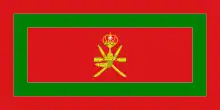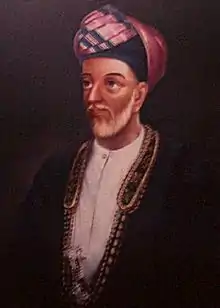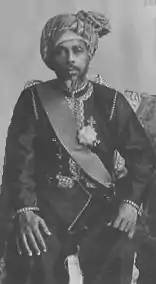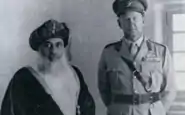List of rulers of Oman
The Sultan of the Sultanate of Oman is the monarch and head of state of Oman. It is the most powerful position in the country. The sultans of Oman are members of the Al Busaidi dynasty, which is the ruling family of Oman since the mid-18th century.
| Sultan of Oman | |
|---|---|
| سلطان عمان | |
 Standard of the Sultan of Oman | |
| Incumbent | |
_(cropped).jpg.webp) | |
| Haitham bin Tariq Al Said since 11 January 2020 | |
| Details | |
| Style | His Majesty |
| Heir apparent | Dhi Yazan bin Haitham |
| First monarch | Al-Julanda bin Masud (imamate) Ahmad bin Said (as Sultan) |
| Formation | 751 (imamate) 1744 (Al Busaid Dynasty) |
| Residence | Al Alam Palace |
| Website | www |
 |
|---|
| This article is part of a series on the politics and government of Oman |
|
|
| Cabinet |
|
|
Since 11 January 2020, Haitham bin Tariq Al Said has been the current sultan.[1]
List of Imams (751–1959)
| Imams | Tribe | Residence | Began to reign | Reference | |
|---|---|---|---|---|---|
| Transliteration of the Arab names | Names in Arab script | ||||
| Al-Julanda bin Masud | الجلندى بن مسعود | Azd | ? | 751 | [2] |
| Mohammed bin Abi Affan | محمد بن أبي عفان | Azd | Nizwa | ? | [3] |
| Al-Warith bin Ka'ab | الوارث بن كعب | Yahmad | Nizwa | 801 | [4] |
| Ghassan bin Abdullah | غسان بن عبد الله | Yahmad | Nizwa | 807 | [5] |
| Abdulmalik bin Humaid | عبد المالك بن حميد | Azd | ? | 824 | [6] |
| Al-Muhanna bin Jayfar | المهنا بن جيفر | Yahmad | Nizwa | 840 | [7] |
| Al-Salt bin Malik | الصلت بن مالك | Azd | ? | 851 | [8] |
| Rashid bin Al-Nadhar | راشد بن النظر | ? | ? | 886 | [9] |
| Azzan bin Tamim | عزان بن تميم | ? | Nizwa | 890 | [10] |
| Mohammed bin Al-Hassan | محمد بن الحسن | Azd | ? | 897 | [11] |
| Azzan bin Al-Hazbar | عزان بن الهزبر | Yahmad | ? | 898 | [12] |
| Abdullah bin Mohammed | عبد الله بن محمد | ? | ? | 899 | [13] |
| Al-Salt bin Al-Qasim | الصلت بن القاسم | ? | ? | 900 | [14] |
| Al-Husn bin Said | الحسن بن سعيد | ? | ? | 900 | [15] |
| Al-Hawari bin Matraf | الحواري بن مطرف | ? | ? | 904 | [16] |
| Omar bin Mohammed | عمر بن محمد | ? | ? | 912 | [17] |
| Mohammed bin Yazid | محمد بن يزيد | Kinda | ? | ? | [18] |
| Al-Hakm bin Al-Milaa Al-Bahri | الحكم بن الملا البحري | ? | Nizwa | ? | [19] |
| Said bin Abdullah | سعيد بن عبد الله | ? | ? | 939 | [20] |
| Rashid bin Waleed | راشد بن الوليد | ? | Nizwa | ? | [21] |
| Al-Khalil bin Shadhan | الخليل بن شاذان | ? | ? | 1002 | [22] |
| Rashid bin Said | راشد بن سعيد | ? | ? | 1032 | [23] |
| Hafs bin Rashid | حفص بن راشد | ? | ? | 1068 | [24] |
| Rashid bin Ali | راشد بن علي | ? | ? | 1054 | [25] |
| Musa bin Jabir | ابن جابر موسى | ? | Nizwa | 1154 | [26] |
| Malik bin Aly | مالك بن علي | ? | ? | 1406 | [27] |
| Salim bin Rashid Al Kharusi | Azdi, Yamani, Qahtani | ? | 1913 - 1919 | ||
| Muhammad ibn Abdullah Al Khalili | ? | 1919 - 1954 | |||
| Ghalib Alhinai | ? | 1954 - 1959 | |||
List of Imams (1406–1749)
Nabhani dynasty (1406–1624)
| Name | Portrait | Reign start | Reign end | Notes |
|---|---|---|---|---|
| Makhzum bin al Fallah |  | 1406 | 1435 | |
| Abul Hassan of Oman |  | 1435 | 1451 | |
| Omar bin al Khattab |  | 1451 | 1490 | |
| Omar al Sharif |  | 1490 | 1500 | |
| Muhammad bin Ismail |  | 1500 | 1529 | Portuguese protectorate imposed on 15 April 1515. |
| Barakat bin Muhammad |  | 1529 | 1560 | |
| Abdulla bin Muhammad |  | 1560 | 1624 |
Yaruba dynasty (1624–1749)
| Name | Portrait | Reign start | Reign end | Notes |
|---|---|---|---|---|
| Nasir bin Murshid |  | 1624 | 1649 | |
| Sultan bin Saif |  | 1649 | 1679 | Portuguese protectorate ended with their expulsion on 1 January 1650. |
| Bil'arab bin Sultan |  | 1679 | 1692 | |
| Saif bin Sultan |  | 1692 | 1711 | |
| Sultan bin Saif II |  | 1711 | 1718 | |
| Saif bin Sultan II |  | 1718 | 1719 | |
| Muhanna bin Sultan |  | 1719 | 1720 | |
| Saif bin Sultan II |  | 1720 | 1722 | Second reign |
| Ya'arab bin Bel'arab |  | 1722 | 1722 | |
| Saif bin Sultan II |  | 1722 | 1724 | Third reign |
| Muhammad bin Nasir |  | 1724 | 1728 | Not a member of the dynasty |
| Saif bin Sultan II |  | 1728 | 1742 | Fourth reign; at first in the coastal area only |
| Bal'arab bin Himyar |  | 1728 | 1737 | First reign; in the interior |
| Sultan bin Murshid |  | 1742 | 1743 | |
| Bal'arab bin Himyar |  | 1743 | 1749 | Second reign; in the interior |
List of Sultans
Al Busaidi dynasty (1749–present)
| Name | Portrait | Reign start | Reign end | Notes |
|---|---|---|---|---|
| Ahmad bin Said |  | 10 June 1749 | 15 December 1783 | From 1744 in the coastal region |
| Said bin Ahmad |  | 15 December 1783 | 1784 | Last direct male descendant of Al Bu Said to hold the office of Imam. He abdicated secular power to his son Hamad and retired to Rustaq where he died in 1803.[28] |
| Hamad bin Said |  | 1784 | 13 March 1792 | |
| Sultan bin Ahmad |  | 13 March 1792 | 20 November 1804 | |
| Salim bin Sultan |  | 20 November 1804 | 14 September 1806 | Co-Rulers |
| Said bin Sultan |  | |||
| 14 September 1806 | 19 October 1856 | Sole Ruler | ||
| Thuwaini bin Said |  | 19 October 1856 | 11 February 1866 | Killed |
| Salim bin Thuwaini |  | 11 February 1866 | 3 October 1868 | Deposed |
| Azzan bin Qais |  | 3 October 1868 | 30 January 1871 | Killed |
| Turki bin Said |  | 30 January 1871 | 4 June 1888 | |
| Faisal bin Turki |  | 4 June 1888 | 9 October 1913 | British protectorate imposed on 20 March 1891.[29][30] |
| Taimur bin Feisal | 9 October 1913 | 10 February 1932 | Abdicated. Died in exile in India on 28 January 1965. | |
| Said bin Taimur |  | 10 February 1932 | 23 July 1970 | Deposed in the 1970 Omani coup d'état. Died in exile in the United Kingdom on 19 October 1972. |
| Qaboos bin Said | .jpg.webp) | 23 July 1970 | 10 January 2020 | British protectorate ended on 2 December 1971. |
| Haitham bin Tariq | _(cropped).jpg.webp) | 11 January 2020 | Incumbent | |
List of the Head of government
Chief ministers (Wazir)
1832 - 1856 Sulayman bin Hamad al-Busa`idi (b. c.1785 - d. 1873)
1868 - 1870 Sa`id bin Khalfan al-Khalili (b. 1811 - d. 1870)
1871 - 13 Aug 1873 Thuwayni bin Muhammad al-Busa`idi (b. 1838 - d. 1873)
1873 - 1888 Sa`id bin Muhammad al-Busa`idi (1st time) (b. 1840 - d. 1901)
1888 - 1895 Muhammad bin `Azzan al-Busa`idi
1896 - 1901 Sa`id bin Muhammad al-Busa`idi (2nd time) (s.a.)
1900 - 1920 Muhammad bin Ahmad al-Ghasham (b. 18.. - d. 1929)
1920 Daniel Vincent McCollum (b. 1886 - d. 1967)
Chairmen of the Council of Deputies
Apr 1920 - 1926 Nadir bin Faysal al-Busa`idi (b. 1888 - d. 1971)
1926 - 1928 Muhammad bin Ahmad al-Ghasham (s.a.)
Chairmen of the Council of Ministers (Prime ministers)
1929 - 1970 Sa`id bin Taimur (s.a.)
28 Jul 1970 - 14 Aug 1970 Barayq bin Hamad (acting)
14 Aug 1970 - 2 Jan 1972 Tariq bin Taimur (b. 1921 - d. 1980) Non-party
2 Jan 1972 - the Sultans
Succession
Unlike the heads of other Arab states of the Persian Gulf, Qaboos did not publicly name an heir. Article 6 of the constitution says the royal family should choose a new sultan within three days of the position falling vacant. If the royal family council fails to agree, a letter containing a name penned by Sultan Qaboos should be opened in the presence of a defence council of military and security officials, supreme court chiefs, and heads of the two quasi-parliamentary advisory assemblies.[31] Analysts saw the rules as an elaborate means of Sultan Qaboos securing his choice for successor without causing controversy by making it public during his lifetime, since it was considered unlikely that the royal family would be able to agree on a successor on its own.[31]
Qaboos had no children nor siblings; there are other male members of the Omani royal family including paternal uncles and their families. Using same-generation primogeniture, the successor to Qaboos would appear to be the children of his late uncle, Sayyid Tariq bin Taimur Al Said, Oman's first prime minister before the sultan took over the position himself (and his former father-in-law). Oman watchers believed the top contenders to succeed Qaboos were three of Tariq's sons: Assad bin Tariq Al Said, Deputy Prime Minister[32] for International Relations and Cooperation[33] and the Sultan's special representative; Shihab bin Tariq, a retired Royal Navy of Oman commander; and Haitham bin Tariq Al Said, the Minister of Heritage and National Culture.[31][34]
On 11 January 2020, Oman state TV said authorities had opened the letter by Sultan Qaboos bin Said naming his successor, announcing shortly that Haitham bin Tariq is the country's ruling sultan.[35] Haitham bin Tariq has two sons and two daughters.[36][37]
On 12 January 2021, the current Sultan, Haitham bin Tariq officially changed the Basic Law of State, stipulating the creation of the post for the Crown Prince of Oman and appointed his first son, Sayyid Dhi Yazan bin Haitham as the apparent successor, making him the first Crown Prince of the Sultanate.
Changes to the rules of succession
On 11 January 2021, the new Sultan, Haitham bin Tariq changed the Basic law of the state and charted out the procedures for succession in the future.
As per the new rules, The power shall be transferred from the Sultan to his eldest son and then to the eldest son of the Heir Apparent. In case the eldest son of the sultan is no more, then the power will be transferred to the eldest son of the Heir Apparent.
If the Heir Apparent has no sons, then the power should be transferred to the eldest of his brothers. In Case the heir apparent has no brothers, then the powers shall transfer to the son of the eldest of his brothers and so on as per the sequence of the ages of the brothers.
In case there exists no brothers or sons of brothers to the Heir Apparent, then the rule shall transfer to the uncles(only from the fathers' side) and their sons as per the order set by the paragraph(2) of the Basic Law of the State. It is also stated the Heir apparent must be a muslim and Legitimate son of Omani Muslim parents.
Article (3) of the Law states that if the transfer of power is made to a person aged under 21, then the power of the Sultan shall be undertaken by a trusteeship council appointed by a Royal Will and in case of non-appointment of such a council before his death, the Royal Family Council will appoint a trusteeship council comprising one of the brothers of the Sultan and two sons of his uncles.
The system of the trusteeship council shall be issued by a Royal Decree. Article (7) states that a Royal Order shall be issued on the appointment of the Heir Apparent to assume power and the prerogatives and duties to be assigned to him.
The Heir Apparent shall be sworn in before the Sultan before exercising his prerogatives and duties.
Article (8) says that in case it is not temporarily possible for the Sultan to exercise his powers, then the Heir Apparent shall assume such powers.
Standard of the Sultan
 Standard of the Sultan of Oman.
Standard of the Sultan of Oman.
See also
- History of Oman
- Muscat and Oman
- Oman proper
- Sultanate of Zanzibar
- List of Sultans of Zanzibar
References
- General
- "Oman's Rulers Through History (Pre-Islam – 12th Century AD)". Ministry of Information of the Sultanate of Oman. Archived from the original on 2011-06-22. Retrieved 2010-07-19.
- "Oman's Rulers Through History (13th Century AD – 18th Century AD)". Ministry of Information of the Sultanate of Oman. Archived from the original on 2010-09-26. Retrieved 2010-07-19.
- "The Al Bu Said Dynasty". Ministry of Information of the Sultanate of Oman. Archived from the original on 2010-05-12. Retrieved 2010-07-19.
- Specific
- "Oman's new ruler Haitham bin Tariq takes oath: newspapers". Reuters. 11 January 2020. Retrieved 11 January 2020.
- Salil-Ibn Razik 1871, p. 7
- Salil-Ibn Razik 1871, p. 9
- Salil-Ibn Razik 1871, p. 10
- Salil-Ibn Razik 1871, p. 12
- Salil-Ibn Razik 1871, p. 15
- Salil-Ibn Razik 1871, p. 16
- Salil-Ibn Razik 1871, p. 19
- Salil-Ibn Razik 1871, p. 19
- Salil-Ibn Razik 1871, p. 20
- Salil-Ibn Razik 1871, p. 25
- Salil-Ibn Razik 1871, p. 25
- Salil-Ibn Razik 1871, p. 26
- Salil-Ibn Razik 1871, p. 26
- Salil-Ibn Razik 1871, p. 26
- Salil-Ibn Razik 1871, p. 26
- Salil-Ibn Razik 1871, p. 27
- Salil-Ibn Razik 1871, p. 28
- Salil-Ibn Razik 1871, p. 29
- Salil-Ibn Razik 1871, p. 29
- Salil-Ibn Razik 1871, p. 30
- Salil-Ibn Razik 1871, p. 35
- Salil-Ibn Razik 1871, p. 35
- Salil-Ibn Razik 1871, p. 35
- Salil-Ibn Razik 1871, p. 35
- Salil-Ibn Razik 1871, p. 36
- Salil-Ibn Razik 1871, p. 36
- Rentz, George (1997) Oman and the south-eastern shore of Arabia Ithaca Press, Reading, Berkshire, United Kingdom : pages 204-205, ISBN 0-86372-199-0
- See Persian Gulf Residency
- Oman
- Dokoupil, Martin (24 May 2012). "Succession Question Fuels Uncertainty in Oman". Reuters. Retrieved 2 August 2012.
- "In Oman, a train-of-succession mystery: Who follows Qaboos?". 17 April 2017 – via Christian Science Monitor.
- "Here is why Social Development Ministry honoured 32 private firms". Times of Oman. Retrieved 2018-12-01.
- "Sultan Qaboos of Oman dies aged 79". 11 January 2020. Retrieved 11 January 2020.
- "Oman names culture minister as successor to Sultan Qaboos". AP NEWS. 11 January 2020. Retrieved 11 January 2020.
- "Oman's new ruler chosen to provide continuity". 11 January 2020 – via www.reuters.com.
- "Who is the new Sultan of Oman?". Tehran Times. 13 January 2020.
Bibliography
- Salil-Ibn Razik (2004) [First published 1871]. الشعاع الشائع باللمعان في ذكر أئمة عمان [History of the Imams and Seyyids of Oman]. trans. Reverend George Percy Badger. Kessinger Publishing. ISBN 978-1-4179-4787-4.